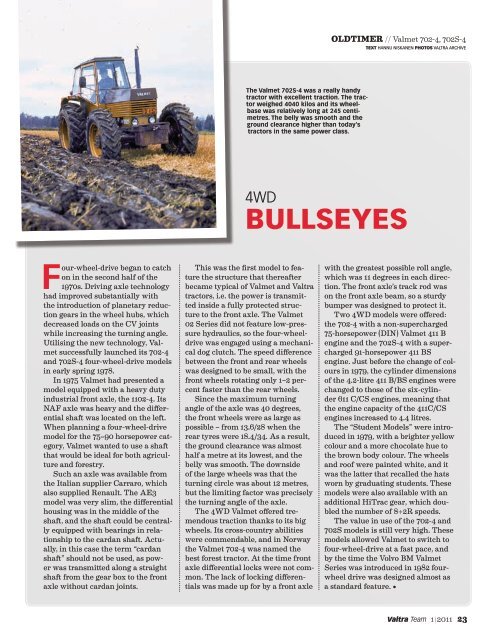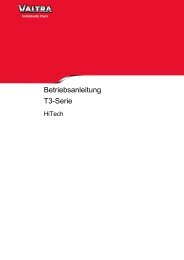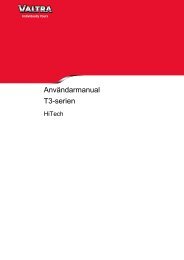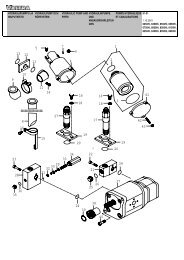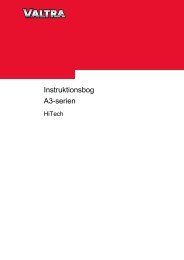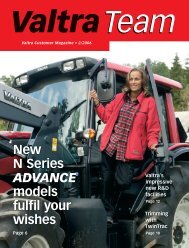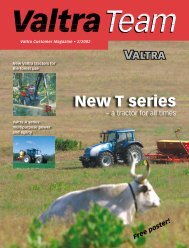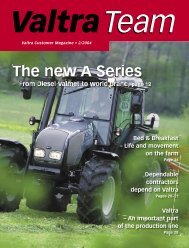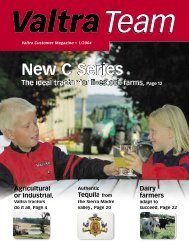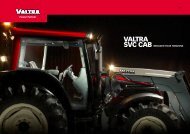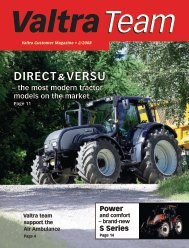You also want an ePaper? Increase the reach of your titles
YUMPU automatically turns print PDFs into web optimized ePapers that Google loves.
Four-wheel-drive began to catch<br />
on in the second half of the<br />
1970s. Driving axle technology<br />
had improved substantially with<br />
the introduction of planetary reduction<br />
gears in the wheel hubs, which<br />
decreased loads on the CV joints<br />
while increasing the turning angle.<br />
Utilising the new technology, Valmet<br />
successfully launched its 702-4<br />
and 702S-4 four-wheel-drive models<br />
in early spring 1978.<br />
In 1975 Valmet had presented a<br />
model equipped with a heavy duty<br />
industrial front axle, the 1102-4. Its<br />
NAF axle was heavy and the differential<br />
shaft was located on the left.<br />
When planning a four-wheel-drive<br />
model for the 75–90 horsepower category,<br />
Valmet wanted to use a shaft<br />
that would be ideal for both agriculture<br />
and forestry.<br />
Such an axle was available from<br />
the Italian supplier Carraro, which<br />
also supplied Renault. The AE3<br />
model was very slim, the differential<br />
housing was in the middle of the<br />
shaft, and the shaft could be centrally<br />
equipped with bearings in relationship<br />
to the cardan shaft. Actually,<br />
in this case the term “cardan<br />
shaft” should not be used, as power<br />
was transmitted along a straight<br />
shaft from the gear box to the front<br />
axle without cardan joints.<br />
The Valmet 702S-4 was a really handy<br />
tractor with excellent traction. The tractor<br />
weighed 4040 kilos and its wheelbase<br />
was relatively long at 245 centimetres.<br />
The belly was smooth and the<br />
ground clearance higher than today’s<br />
tractors in the same power class.<br />
This was the first model to feature<br />
the structure that thereafter<br />
became typical of Valmet and <strong>Valtra</strong><br />
tractors, i.e. the power is transmitted<br />
inside a fully protected structure<br />
to the front axle. The Valmet<br />
02 Series did not feature low-pressure<br />
hydraulics, so the four-wheeldrive<br />
was engaged using a mechanical<br />
dog clutch. The speed difference<br />
between the front and rear wheels<br />
was designed to be small, with the<br />
front wheels rotating only 1–2 percent<br />
faster than the rear wheels.<br />
Since the maximum turning<br />
angle of the axle was 40 degrees,<br />
the front wheels were as large as<br />
possible – from 13.6/28 when the<br />
rear tyres were 18.4/34. As a result,<br />
the ground clearance was almost<br />
half a metre at its lowest, and the<br />
belly was smooth. The downside<br />
of the large wheels was that the<br />
turning circle was about 12 metres,<br />
but the limiting factor was precisely<br />
the turning angle of the axle.<br />
The 4WD Valmet offered tremendous<br />
traction thanks to its big<br />
wheels. Its cross-country abilities<br />
were commendable, and in Norway<br />
the Valmet 702-4 was named the<br />
best forest tractor. At the time front<br />
axle differential locks were not common.<br />
The lack of locking differentials<br />
was made up for by a front axle<br />
oLDTiMer // Valmet 702-4, 702S-4<br />
4WD<br />
bUllSEYES<br />
TExT HannU nIsKanen PHOTOS valtra arCHIve<br />
with the greatest possible roll angle,<br />
which was 11 degrees in each direction.<br />
The front axle’s track rod was<br />
on the front axle beam, so a sturdy<br />
bumper was designed to protect it.<br />
Two 4WD models were offered:<br />
the 702-4 with a non-supercharged<br />
75-horsepower (DIN) Valmet 411 B<br />
engine and the 702S-4 with a supercharged<br />
91-horsepower 411 BS<br />
engine. Just before the change of colours<br />
in 1979, the cylinder dimensions<br />
of the 4.2-litre 411 B/BS engines were<br />
changed to those of the six-cylinder<br />
611 C/CS engines, meaning that<br />
the engine capacity of the 411C/CS<br />
engines increased to 4.4 litres.<br />
The “Student Models” were introduced<br />
in 1979, with a brighter yellow<br />
colour and a more chocolate hue to<br />
the brown body colour. The wheels<br />
and roof were painted white, and it<br />
was the latter that recalled the hats<br />
worn by graduating students. These<br />
models were also available with an<br />
additional HiTrac gear, which doubled<br />
the number of 8+2R speeds.<br />
The value in use of the 702-4 and<br />
702S models is still very high. These<br />
models allowed Valmet to switch to<br />
four-wheel-drive at a fast pace, and<br />
by the time the Volvo BM Valmet<br />
Series was introduced in 1982 fourwheel<br />
drive was designed almost as<br />
a standard feature. •<br />
<strong>Valtra</strong> <strong>Team</strong> <strong>1|2011</strong> 23


